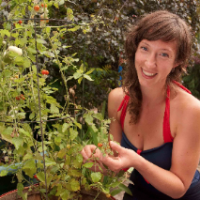Kate Leinweber, B.Sc R.H.N
Fermented Food Saved my Stomach!
Many years ago I was suffering from the irregular and confusing symptoms of Irritable Bowel Syndrome. Although I was in complete denial of having any kind of “syndrome”, I would experience stomach aches frequently, along with gassy bloating and irregular bowel movements. (That’s right, BMs! A nutritionists favorite subject!)
It seemed that no one food was really a trigger. In fact, once a simple banana caused me to have a crippling stomach ache.
What was happening to me was something called Hypochlorhydria or an Underactive Stomach. This is when the stomach does not produce enough Hydrochloric acid (HCl) to allow for proper digestion. The symptoms of this are stomach aches, belching, gas, bloating, heartburn and frequent loose bowel movements.
As I searched for the food that was my trigger I took almost all foods out of my diet! I was missing the point that maybe there was a therapeutic food out there that would prevent these painful “Underactive Stomach Events.”
It was a talented chef that facilitated a workshop on fermentation that taught me the concept of therapeutic foods. In this workshop we made kombucha, brined vegetables, kimchi and sauerkraut. The whole workshop she talked about the digestive system and how ferments helped to stimulate digestion, prevent gas and bloating, and induce regular BMs. It was exactly what I needed at the time.
As per my usual pattern I became a complete fermentation geek! I even flew to Nashville for a fermentation intensive with Sandor Katz (a fermentation guru of sorts.) My kitchen was full of different jars of liquids, vegetables and even yogurts. I discovered my love of the sour flavour of fermented foods and a lovely side effect was the reduction in my stomach complaints! In the moment of having a stomach ache I would drink the brine from one of my sauerkrauts and experience relief in just a few minutes. Oh it was fabulous. And my first experience with how acutely therapeutic a food can be.
Fermented foods are a part of traditional cultures all over the world. Today’s modern food system has replaced lacto-fermentation with distilled vinegar to give sauerkraut and pickles that sour flavor. But of course, distilled white vinegar does not have the therapeutic effect of increasing stomach acid (it actually decreases it over time) nor does it have the healthy bacteria to repopulate the intestines to prevent gas and bloating. The therapeutic effect comes from the traditional method of fermentation.
Fermentation is an ancient process used in all traditional forms of cuisine around the world. Originally it was used as a mode of food preservation to keep dairy products before the time of refrigeration, to keep vegetables through the winter or to reduce inhibitions through imbibing alcoholic beverages. Today ferments are returning to modern kitchens for their health benefits.
Scientifically the process of fermentation breaks down food in a pre-digestion that increases the amounts of vitamins (especially B vitamins & vitamin C), minerals, protein and improves absorbability of nutrients. The enzyme inhibitor Oxalic acid found in green leafy vegetables is inhibited releasing important minerals like Calcium. The bacteria that conduct the fermentation contribute probiotics to the intestines reducing digestive discomfort and boosting the immune system. The bacteria themselves produce enzymes. These enzymes help the body to digest, to reduce inflammation, and prevents gas and bloating.
Did you know that 80% of our immune system is in our gut and primarily depends on the bacteria that live there? Did you know that there are more bacterial cells than human cells in our body?! Traditional fermented foods are a great way to improve the flora of our intestines and maintain health.
In my wintery Canadian climate fermented vegetables allow me to consume the necessary vitamins and minerals normally obtained from a diet of fresh foods during the spring and summer. A novel yet traditional idea that provides us with an alternative to importing vegetables from the other side of the world.
So, how do I make it?
Sauerkraut
What is so great about Cabbage you ask? It beautifies the skin, benefits digestion and moistens the intestines. High in sulfur, iodine, and vitamin C, which also makes it great for the thyroid and metabolism.
- Cut up any veggies you want: cabbage, kale, radish, carrot, beet, chard etc etc, the options are limitless!
- Add enough salt to taste and mash up with your hands until the vegetables let go of some of their water and gets a little slimy.
- Press down into a crock until the juices rise above the vegetables. Flavour as you like. Caraway seeds and Juniper berries are common in sauerkraut.
- Cover well and let sit in a warm place.
- Check your ferment daily and give it your LOVE! Later you and your family will ingest that love!
- Press down your ferment daily so all the gas bubbles rise to the top and again the liquid rises above the vegetables.
- When it tastes sour and delicious it is ready!
If there is any green moldy stuff or scum that grows on the surface. Just scoop it off, add it to your compost and forget it was ever there! Mold can only grow in the presence of Oxygen, so it will only grow on the surface of your ferment. (Trust me, I’m a Microbiologist!)
You can prevent mold by pressing the vegetables below the surface of the liquid.
Enjoy!





Read 10 comments and reply